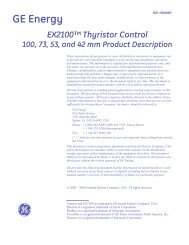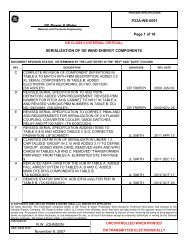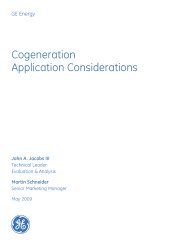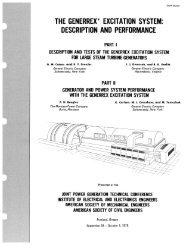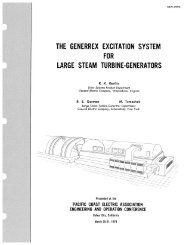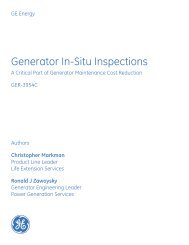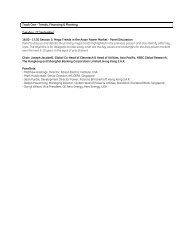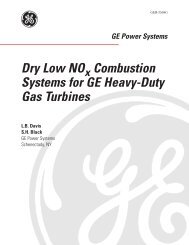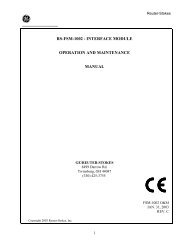GER3688B - GE Generators - An Overview - GE Energy
GER3688B - GE Generators - An Overview - GE Energy
GER3688B - GE Generators - An Overview - GE Energy
Create successful ePaper yourself
Turn your PDF publications into a flip-book with our unique Google optimized e-Paper software.
INTRODUCTION<br />
The history of <strong>GE</strong>’s design, manufacture and<br />
development of electric generators has been a<br />
long and varied one. Since the early 1900s more<br />
than 10,000 <strong>GE</strong> generators have been shipped<br />
and placed in service at utility companies and<br />
industrial plants, and as ship service units. The<br />
designs have evolved from slow-speed vertical-<br />
shaft units to high-speed horizontal shaft air-<br />
cooled units, through indirect hydrogencooled<br />
units to direct water-cooled units.<br />
During the 1950s through the mid-1970s much<br />
emphasis was placed on developing units to sup<br />
port the rapid growth in unit ratings, which<br />
increased from 100 MW to more than 1100 MW.<br />
It was during this time frame that such innovative<br />
design features as direct water-cooled armature<br />
windings, gap-pickup rotor winding cooling,<br />
Micapal II TM stator insulation, Class F rotor and<br />
stator insulation, advanced TetralocTM stator end-<br />
winding support systems, and the side ripple-<br />
spring armature bar slot support structure were<br />
developed.<br />
In the early 1960s packaged gas-turbinedriven<br />
generators were introduced. These applications<br />
were characterized by the ambient-temperature-<br />
following nature of the gas turbine output and the<br />
ability of the gas turbine to provide peaking capa-<br />
bility for short periods. Generator designs were<br />
developed which were tailored to gas turbine<br />
applications. As new gas turbines were intro-<br />
duced, or as older designs were uprated, genera-<br />
tor designs were introduced to match the new gas<br />
turbine ratings.<br />
Over the course of the past decade, the empha-<br />
sis in new electric power generation installations<br />
has swung away from large units delivering major<br />
blocks of power to smaller units operated not only<br />
by utilities, but by cogenerators or other smaller<br />
independent power production companies. In<br />
response to this change, <strong>GE</strong> is placing a major<br />
emphasis on the design and development of gen-<br />
erators suited to these applications.<br />
Excluding marine service applications, <strong>GE</strong> cur-<br />
rently has more than 6400 generators in service<br />
(Figure 1) . These generators can be placed in three<br />
major design classifications based on the cooling<br />
medium used: air, hydrogen and liquid cooled. This<br />
<strong>GE</strong> <strong>GE</strong>NERATORS - AN OVERVIEW<br />
J. J. Gibney, III<br />
<strong>GE</strong> Industrial & Power Systems<br />
Schenectady, NY<br />
NUMBER OF UNITS IN SERVICE -<br />
BY COOLING TYPE<br />
Air Cooled<br />
Liquid Hydrogen Open<br />
Cooled Cooled Ventilated TEWAC Total<br />
___ ~<br />
Steam<br />
rurbine-Driven 520 3,006 2 1,164 4,712<br />
Gas<br />
Turbine-Driven 1 214 1,340 151 1,706<br />
Totals 521 3,220 1,342 1,335 6,416<br />
Figure 1. <strong>GE</strong> generator experience<br />
paper will give an overview of each of these basic<br />
design classifications.<br />
DESIGN CONSIDERATIONS<br />
The design of synchronous generators is an<br />
optimization process. A generator design engi-<br />
neer’s challenge is to develop a final design that,<br />
as best as is practical, optimizes the overall size,<br />
efficiency, performance capabilities and electrical<br />
parameters, while maintaining mechanical, ther-<br />
mal and magnetic limits. In addition, the designer<br />
must be aware of the need to minimize the overall<br />
cost impact of the design.<br />
The development of modern analytical calcu-<br />
lation methods, including finiteelement analysis,<br />
supplemented with the use of improved materi-<br />
als, building upon component testing, has aided<br />
the generator designer in the pursuit of an opti-<br />
mal design.<br />
AIR-COOLED <strong>GE</strong>NERATORS<br />
Air-cooled generators are produced in two<br />
basic configurations: open ventilated (OV) and<br />
totallyenclosed water-to-air-cooled (TEWAC) . In<br />
the OV design, outside air is drawn directly from<br />
outside the unit through filters, passes through<br />
the generator and is discharged outside the gener-<br />
ator. In the TEWAC design, air is circulated within<br />
the generator passing through frame-mounted<br />
air-to-water heat exchangers.<br />
The recent emphasis in the marketplace on<br />
steam and gas turbinegenerators in the 20- to lOO-<br />
MVA size has provided <strong>GE</strong> with the impetus to<br />
<strong>GE</strong>R-3688B



